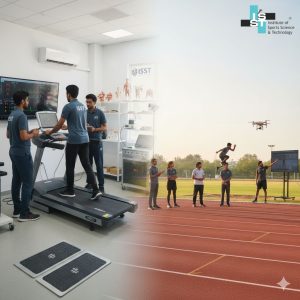Introduction: Redefining the Game
For centuries, sports have been a cornerstone of human civilization, bringing communities together, inspiring passion, and pushing the boundaries of human achievement. Traditionally, the experience of sports has been rooted in physicality: watching games from the stands, feeling the energy of the crowd, and participating in athletic endeavors. However, the advent of virtual reality (VR) and augmented reality (AR) is poised to revolutionize the way we experience and interact with sports, blurring the lines between the digital and physical worlds.
How VR is Transforming the Athlete’s Experience
VR technology offers athletes a unique opportunity to train and improve their skills in a highly immersive and controlled environment. By simulating real-world game scenarios, athletes can practice against virtual opponents, analyze their performance in real-time, and identify areas for improvement. This technology can be particularly valuable for sports that require complex coordination, such as golf, tennis, and baseball. For instance, a golfer can practice their swing against a virtual course, receiving instant feedback on their form and ball trajectory.
How AR is Enhancing Athlete Performance
Augmented reality, on the other hand, enhances the real world by overlaying digital information on top of it. In the context of sports, AR can be used to provide athletes with real-time data and insights that can help them make better decisions on the field. For example, a football player could see the positions of their teammates and opponents overlaid on the field, allowing them to anticipate plays and make more informed decisions. Additionally, AR can be used to refine athletic technique by visualizing proper form and providing instant corrections.
The Future Fan: Immersive Experiences Like Never Before
VR and AR are not only transforming the athlete’s experience but also revolutionizing the way fans consume sports. VR broadcasts offer fans the opportunity to experience games from a 360-degree perspective, as if they were sitting in the stadium. This technology can also provide fans with virtual seating options, allowing them to choose their preferred viewing angle and even interact with other fans in a virtual environment.
Furthermore, AR can enhance the stadium experience by providing fans with real-time information, such as player statistics, game highlights, and personalized offers. For example, fans could use their smartphones to view interactive overlays on the field, providing them with additional context and insights into the game.
The Rise of E-sports: Virtual Competition on the Rise
The convergence of VR and AR with gaming has led to the rise of e-sports, a competitive form of video gaming that has gained immense popularity in recent years. E-sports tournaments are now broadcast globally, attracting millions of viewers and generating significant revenue. As VR and AR technology continues to advance, we can expect to see even more immersive and engaging e-sports experiences, further blurring the lines between traditional sports and virtual competition.
Blurring the Lines: Can VR/AR Replicate the Real Thing?
While VR and AR offer a wide range of benefits for athletes and fans, there is still a debate about whether these technologies can truly replicate the experience of watching and participating in live sports. The physicality, the energy of the crowd, and the sense of community that comes with attending a sporting event are difficult to recreate in a virtual environment. However, as VR and AR technology continues to evolve, it is possible that we will see increasingly realistic and immersive experiences that can complement, rather than replace, traditional forms of sports consumption.
Beyond the Game: The Broader Impact of VR/AR in Sports
The impact of VR and AR on sports extends beyond the game itself. These technologies have the potential to make sports more accessible to people with disabilities, providing them with new opportunities to participate and enjoy athletic activities. Additionally, VR and AR can be used to enhance educational experiences for athletes and fans, providing them with deeper insights into the science and history of sports.
Ethical Considerations: Balancing Technology with the Spirit of Sportsmanship
As VR and AR technology becomes more integrated into the world of sports, it is important to consider the ethical implications of these advancements. There are concerns about the potential for cheating and manipulation in VR-enhanced competitions, as well as the impact of excessive screen time on the physical and mental health of athletes and fans. It is essential to establish guidelines and regulations to ensure that the use of VR and AR technology in sports is fair, transparent, and beneficial to all involved.
The Future is Now: Investing in VR/AR Technology for Sports
The future of sports is bright, and VR and AR technology are playing a key role in shaping that future. Sports organizations are investing heavily in these technologies to enhance the fan experience, improve athlete performance, and generate new revenue streams. However, the successful adoption of VR and AR in sports will require a concerted effort from all stakeholders, including athletes, teams, leagues, and technology companies.
Conclusion: A New Era for Sports Dawns
As we look ahead, it is clear that VR and AR are ushering in a new era for sports. These technologies have the potential to transform the way we experience, participate in, and connect with athletic endeavors. By embracing innovation and addressing the challenges associated with these technologies, we can create a future where sports are more accessible, engaging, and exciting than ever before.
Inspiring Quote about the Future of Sports
“The future of sports is not just about watching games; it’s about experiencing them in a way that transcends our physical limitations and expands our imagination.” – Unknown
FAQs
1. What are the limitations of VR/AR technology in sports?
While VR and AR offer numerous benefits, they also have limitations. For example, the hardware required for these technologies can be expensive and may not be accessible to everyone. Additionally, there are concerns about the potential for motion sickness and discomfort, particularly for those who are not accustomed to immersive experiences. Furthermore, the quality of VR and AR experiences can vary depending on the hardware and software used.
2. How will VR/AR impact the cost of attending sporting events?
VR and AR technology could potentially impact the cost of attending sporting events in several ways. On the one hand, it could make it more affordable for fans to experience games from the comfort of their own homes. On the other hand, teams and leagues may choose to increase ticket prices to offset the costs of implementing VR and AR technology in their stadiums. Ultimately, the impact on ticket prices will depend on a variety of factors, including the popularity of the sport, the demand for VR and AR experiences, and the overall economic climate.
3. Can VR/AR create a sense of community and belonging for fans?
While VR and AR can provide fans with immersive and engaging experiences, it remains to be seen whether they can truly replicate the sense of community and belonging that comes with attending live sporting events. The social interactions, the energy of the crowd, and the shared experiences that occur at stadiums are difficult to recreate in a virtual environment. However, VR and AR could potentially create new opportunities for fans to connect with each other online, fostering a sense of community among like-minded individuals.
4. How can athletes ensure fair play in a VR/AR-enhanced environment?
Ensuring fair play in VR and AR-enhanced sports requires careful consideration and regulation. Leagues and governing bodies must establish rules and guidelines to prevent cheating and manipulation, such as the use of performance-enhancing software or hacking. Additionally, athletes must be educated about the potential risks of using these technologies and held accountable for any violations of the rules.
5. What role will institutes like ISST Pune play in shaping the future of sports technology?
Institutes like ISST Pune play a crucial role in shaping the future of sports technology by conducting research, developing innovative solutions, and training the next generation of sports professionals. These institutions can contribute to the development of new VR and AR technologies specifically designed for sports, as well as explore the ethical implications of these advancements. Additionally, ISST Pune can provide education and training programs to help athletes and coaches understand and utilize these technologies effectively.












